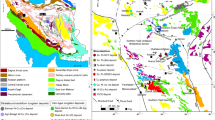Abstract
The Pennaichaung and Yetkanzintaung W-Sn Prospects are located in Tavoy Township, Tennasserim Division, southern Burma. The W-Sn mineralization at the Pennaichaung is closely related with a small, satellitic granitoid pluton of presumably Late Mesozoic age, which intruded the metaclastic rocks of Mergui Group (mostly Carboniferous). The mineralized quartz veins at the Pennaichaung penetrated the granitoid-metasedimentary rocks contact. In contrary to the Pennaichaung deposit, the W-Sn veins at the Yetkanzintaung are exclusively in the metasedimentary rocks of slates and quartzites of Margui Group. Mineralized quartz veins in the Pennaichaung area trend NNE-SSW, NW-SE and NE-SW with a maximum thickness of 30 cm, but only quartz veins trending NNE-SSW are found to be productive and contained economically workable wolframite and cassiterite. Majority of the mineralized quartz veins in the Yetkanzintaung area trend approximately N-S with easterly dip of 50°–70°. The thickness of the ore veins in the Yetkanzintaung area are thinner than those of the Pennaichaung and range from 1 cm to 20 cm with an average width of 5 cm. Fluid inclusion studies of the quartz from the ore veins cutting the granitoid in the Pennaichaung area have yielded a filling temperature range of 170°–270°C with a maximum mode of 220°C, while quartz crystals from the ore veins in the nearby metasedimentary rocks gave a filling temperature range of 140°–220°C with a maximum mode of 160°C. Hence, the Pennaichaung deposit was thought to have emplaced under a filling temperature range of 140°–270°C. A similar low filling temperature range was recorded for the Yetkanzintaung deposit. Quartz from the Yetkanzintaung ore veins have yielded filling temperatures of 200°–240°C, whereas the fluorites associated with the mineralized quartz veins gave a temperature range of 140°–160°C. Limited freezing runs indicate a salinity of less than 5 NaCl equivalent weight percent for inclusions in quartz from both orebodies. No fluid inclusion evidence of boiling of ore fluids nor presence of liquid CO2 was observed in this study. Thus, the ore fluids responsible for the W-Sn mineralization at the Pennaichaung and Yetkanzintaung areas were of low temperature, diluted, CO2-deficient, NaCl brines.
Similar content being viewed by others
References
Brown, J.C., Heron, A.M.: The geology and ore deposits of Tavoy District. Memoirs Geol. Surv. India, vol. XLIV Part II, 354 pp (1923)
Grant, J.N., Halls, C., Avila Salinas, W., Avila, G.: Igneous geology and the evolution of hydrothermal systems in some subvolcanic tin deposits of Bolivia in Volcanologic processes in ore genesis. London, Instn. Mining Metall. 117–126 (1977)
Kelly, W.C., Turneaure, F.S.: Mineralogy, paragenesis and geothermetry of the tin and tungsten deposits of the eastern Andes, Bolivia. Econ. Geol. 65, 609–680 (1970)
Kelly, W.C., Rye, R.O.: Geologic, fluid inclusion and stable isotope studies of the tin-tungsten deposits of Panasquiera, Portugal. Econ. Geol. 74, 1721–1822 (1979)
Khin Zaw: Fluid inclusion studies on the Hermyingyi tungsten-tin deposit, southern Burma. Proceeding of the Third Regional Conference on Geology and Mineral Resources of Southeast Asia, Bangkok 1978, 393–397 (1978)
Khin Zaw, Khin Myo Thet: A note on a fluid inclusion study of tin-tungsten mineralization at Mawchi Mine, Kayah State, Burma. Econ. Geol. 78, 530–534 (1983)
Landis, G.P., Rye, R.O.: Geologic, fluid inclusion and stable isotope studies of the Pasto Bueno tungsten-base metal ore deposit, northern Peru. Econ. Geol. 69, 1025–1059 (1974)
Little, W.M.: Inclusion in cassiterite and associated minerals. Econ. Geol. 55, 485–509 (1960)
Moore, J., Moore, D.J.: Fluid inclusion study of mineralization at St. Michael's Mount, Cornwall. Trans. Instn. Mining Metall. 88 B, 57–60 (1979)
Roedder, E.: Studies of fluid inclusions I: Low temperature application of heating stage. Econ. Geol. 57, 1045–1067 (1962)
Sawkins, F.J.: Preliminary fluid inclusion studies of the mineralization associated with the Hercynian granites of southwest England. Trans. Instn. Mining Metall. 75 B, 109–112 (1966)
Takenouchi, S., Kennedy, G.C.: The binary system H2O-CO2 at high temperatures and pressures. Am J. Sci. 262, 1055–1074 (1964)
Author information
Authors and Affiliations
Rights and permissions
About this article
Cite this article
Zaw, U.K. Geology and geothermometry of vein-type W-Sn deposits at Pennaichaung and Yetkanzintaung Prospects, Tavoy Township, Tennasserim Division, southern Burma. Mineral. Deposita 19, 138–144 (1984). https://doi.org/10.1007/BF00204675
Received:
Accepted:
Issue Date:
DOI: https://doi.org/10.1007/BF00204675




